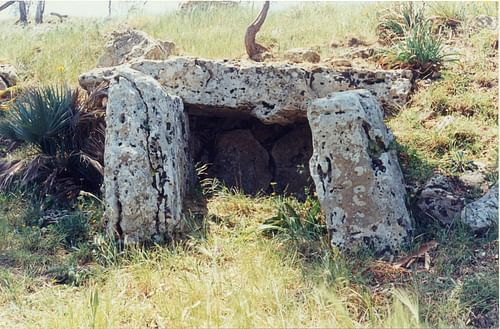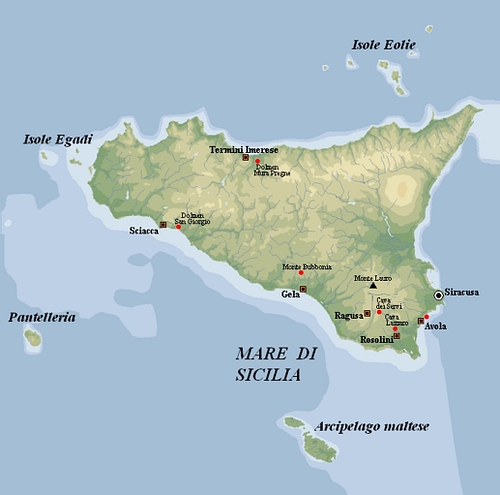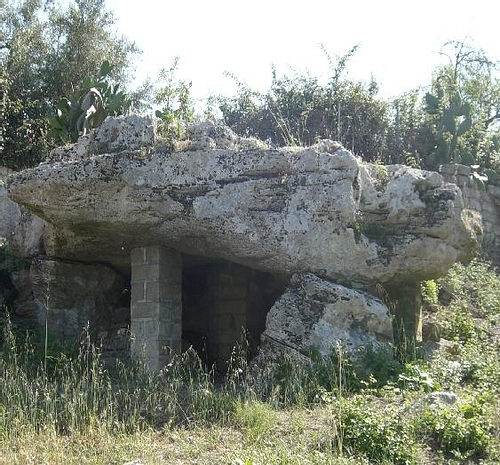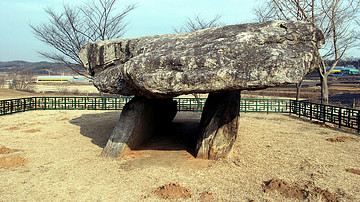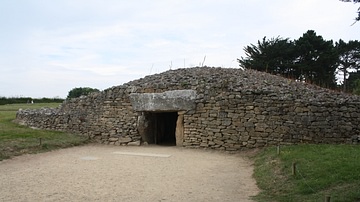It is a well-known fact that Sicily, the largest island in the Mediterranean sea, went through a quite complex prehistoric period. So much so that it is difficult to navigate through the muddle of people that have followed each other over the centuries. The impact of two influences, however, remains clear: one from Europe which came from the North-West, and one from the Mediterranean which had a clear Middle Eastern matrix.
The Mediterranean Context
In recent years this island has revealed, similar to other Mediterranean areas, the presence of small dolmen monuments, which are found almost everywhere, both inland and along its coast. Such monuments, already known in Northern Europe with larger dimensions, have intrigued scholars for centuries, and with the scientific and technical advances of modern archaeology, we are finally beginning to understand something of their purpose and the meanings that they had to the people who built them. They are a type of tomb, usually consisting of two or more vertical megaliths supporting a flat horizontal capstone (table) to form a construction where the structural elements frame a quadrangular space. In actual fact, the typical configuration of the dolmens is trilithic, even though some of these evolved into rather complicated constructions, as is the case of the false dome dolmens, where the shrinkage of the roof was obtained by gradually decreasing the distance between the slabs of the building or in constructions made up of a series of cells around the central one.
In each region, however, unforeseen problems were faced in regards to the collection and transport of construction materials. In the areas where the stone was extremely hard and difficult to crush, they raised enormous monuments; whereas, in other places where the stone was easy to chip, dry-stone method structures were built rather than using the real megalithic technique. This is the case with Sicily, where there are currently five or more of them. The archaeological evidence shows that at least one of these monuments, namely that of Cava dei Servi, was used as a burial place, revealing the actual purpose for which they were built here.
Mediterranean dolmens date back to a more recent era than the Atlantic ones (between the end of the 3rd and the first half of the 2nd millennium BCE), and they are present in the Balearic Islands (Spain), the island of Sardinia (Italy), Apulia (southern Italy) and Malta. Malta is home to the most extraordinary prehistoric sites of the Mediterranean, the “megalithic temples”: they were built between about 4000 and 2500 BCE and are dedicated to a cult worshipping a fertility goddess. The dolmens there, however, date back to the successive period (the second half of the 3rd millennium BCE). In most cases they are small chambers, with the cover made from a large slab placed on upright stones, belonging to a population which is definitely different from that which built the previous megalithic temples, which presumably arrived from the Apulia due to the similarity of the constructions also found there.
Monte Bubbonia
Similar dolmens to the locations mentioned above can be found in Sicily. Such as that of Monte Bubbonia, a majestic hill 595 metres high, 20 kms from the town of Gela. The monument is made up of colossal slabs of rock, with no significant modifications and rectangular in shape. A chalk slab acts as the cover and rests on two parallel megaliths forming a chamber of about 2.60 square metres. The back is embedded in the natural slope of the ground, while the rear wall was created by joining two polygonal slabs. Frequent landslides have resulted in a visible tilting to the right, causing a narrowing of the initial part of the chamber. The entrance, which opens to the northeast, follows the same astronomical orientation of all the Sicilian dolmen. The original architectural idea was, without doubt, a small tomb room, as found in Sardinia and in Apulia, with the back wall placed against the steep slope of the hillside to facilitate burial, as was the norm for this type of architecture.
Cava DEI Servi
More to the north-east, on the Iblean Plateau, a place named Cava dei Servi was the site of human settlements from the Bronze Age (c. 2200 BCE) until the first Pantalica Culture period (c. 1270 BCE), an era in which many burials within small artificial caves excavated alongside the rock walls belong. This area, which is not far from the Monte Lauro elevation, guaranteed excellent commercial opportunities thanks to the quarrying of flint, as it was easy to transport along the streams of the Tellaro and Anapo Rivers. On the highest part of the elevation, a medium-sized slab construction dominates a landscape that cannot help but arouse mystic sensations.
The monument is semi-oval in shape, made up of four rectangular slabs fixed into the ground with another three slabs on top, which lean in such a way that they reduce the surface area and form a sort of “false dome”. Two large and parallel piped-shaped boulders complete the construction. The four vertical bend-forming stones have more or less uniform dimensions, which demonstrate construction capabilities to create the corresponding adhesion between the individual elements. The three inclining slabs that were placed on top, however, have irregular dimensions, due to the fact that they weren't designed to guarantee stability, therefore precision would have been superfluous.
Inside the chamber, there is a large chalky slab that has been fractured in four places. It would seem that it was the vault stone of the monument and that it crashed to the ground due to numerous landslips which affected the structure. All the pieces, in fact, would have been part of a large monolith, squared in front to fit the closing door. The arrangement of the stones gave shape to a building of about 3.00 square meters, located on the slope of the hill to facilitate the burial of the building.
The numerous human bone fragments (the only organic clues found so far inside a Mediterranean dolmen) and some splinters of Castelluccian ceramics (a Sicilian Culture of the Early Bronze Age), have determined the function and chronology of this unique building. Anthropic remains confirmed the burial nature of the site, while fragments of terracotta, although few, have allowed us to date the dolmen back to the bronze age. The positioning around a rocky cemetery confirms the belief that we are not dealing with an attempt to overcome a particularly demanding and dangerous architectural structure, like the small artificial cave. We are actually faced with some absolutely unique elaborations. This location, therefore, will have also had a dolmen necropolis. Similar structures have been found in the Iberian peninsula, Sardinia, Apulia and on the nearby island of Malta, where they might have a common origin with this Sicilian phenomenon. The mystery that hangs over the Maltese and Sicilian dolmen builders could be unravelled right here in Sicily.
Around 2500 BCE, the advanced Tarxien Civilization (named after the namesake Maltese place) of the little Archipelago south of Sicily, with its large complex of four megalithic temples, suddenly disappeared. The Maltese archaeologist Themistocles Zammit, in the early 1900s CE, hypothesised that the exceptional event was probably due to a devastating plague that wiped out the inhabitants of those small islands. Another ethnic group moved there some centuries later; the traces of this new population, however, were immediately found, in the Tarxien cremation cemetery. Hence the name Culture of Tarxien Cemetery (c. 2500-1500 BCE). Therefore there must have been an outright invasion, perpetrated by people who at first were thought to have come from the Aeolian Islands, due to the resemblance of their pottery with that of a Culture of Lipari Island, Capo Graziano. However, Lipari not only lacks the most elaborate forms of Tarxien cemetery, the decorations are also different. This would exclude the invaders from that island. The discovery of some ceramics in the "Tarxien Cemetery" style, within two Maltese dolmens (architectures outside the Aeolian Islands), suggests that the small megaliths of Gozo and Malta are to be attributed to the people of this new "Culture". The fact that these monuments were used as tombs, however, remained a hypothesis, perhaps assured after the discovery of anthropic remains in the "Cava dei Servi" dolmen, whose shape resembles similar structures in a vast area of the Mediterranean.
Avola
Another Sicilian dolmen is located in Avola, a large coastal town which lies between the rivers Assinaro and Cassibile. Here, the slow process of erosion caused by the waters has outlined a valley there, called Cava L'Unica, in Contrada Borgellusa, where, adjacent to a rocky wall, next to the bed of a stream, is a megalithic monument.
The building, surrounded by dense and wild vegetation, at first glance, appears to consist of a huge "limestone plate" of varying thickness, essentially resting on two "pillars". The stone is massive with a rippled surface. It measures 8 meters long and 5.5 across. The northern part, which appears to be on an isolated and informal pillar, is more consistent, tending to a thickness of about half a meter in the eastern part, which, in turn, rests on what is an elevation of the soil with a very broad base. Here you find the rocky back wall, from which the huge slab is objectively detached due to a fracture line and a semicircle bar, which is the part behind. The left "pillar" is connected to this wall.
On the surface of the slab, it is split into two points; there are ten small rectangular incisions. They were produced in the thickest part of the slab, otherwise oriented to not weaken the limestone. The pits have different lengths and vary from 60 cm to 1.2 m with the last pit interrupted by the fracture of the southern end. The depth does not exceed 40 cm. It is perhaps in front of some tombs for children, used in Greek or Paleochristian times. Two grooves run along the outmost eastern side of the slab and they meet at a right-angle. Certain fantastic “literature” came to the conclusion that these two incisions could be defined as draining lines for the blood to run along from sacrificed victims. However, they are notches resulting from the extraction of a block of limestone, of about one cubic metre, drawn from the point where the thickness allowed.
According to geologists, the formation of the cavity is the result of selective erosion of the rock. The continuing action of the erosion processes, rifts, seismic events and Bradyseism, involving the area in question, caused the detachment of the cavity from the rock wall. There is no doubt that this is a natural form of erosion, which is quite frequent along coastal cliffs and river valley banks. It is equally evident that in prehistoric times the original natural form was reshaped by human hands following the natural lines of the boulder, intending to amplify and geometrically refine the cavity to its present appearance. Traces of such intervention are visible both around the pillars taken from the side walls of the cave, giving them a pseudo-parallelepiped form, as well as on the flat surface of the calcarenite vault. The base of the vault has been cleared of underlying sandy-arenite materials, following the surface of lower stratification.
Therefore, human intervention is not excluded on a natural fixture that might have been adapted to experimented architectural elaborations. Perhaps the intervention was for dwelling purposes, but the side opening is incompatible with the logic of a domestic refuge. If it had been a shelter, the work carried out by man would have made it so vulnerable that the possibility of it being a “shelter” is completely illogical. The approach, on the other hand, seems to be an effort to “monumentalise” a structure provided by Nature, saving man from the bulk of the work. It can be compared to any well-thought-out Megalithic construction in Atlantic Europe.
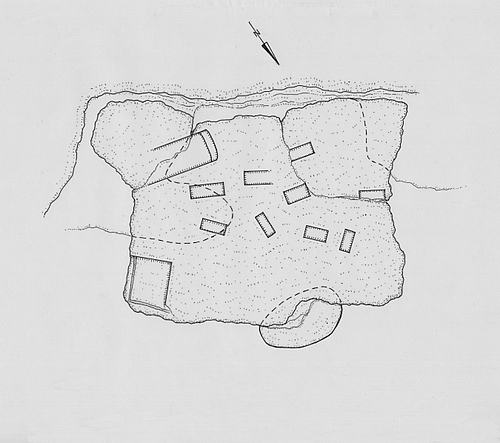
The lack of actual material evidence does not allow us to make judgments; therefore, we feel obliged to classify it as a pseudo dolmen, hoping that new archaeological research will clarify a doubt that has lasted for many years.
The centre of the Ancient World
Megalithism, as we have mentioned, is mainly concentrated in the European Atlantic area, following a course that seems to go back down the continent from the North (England, Brittany) to the South (Portugal, Spain). Around the end of the 3rd millennium BCE, the west coast of Sicily was caught up in a cultural wave (bringing the bell-beaker) coming from the Sardinian coast. The effects of this led to the creation of a second commercial hub also in the southwest of the island in order to regulate the trade between Central-Southern Sicily, Sardinia and the Iberian peninsula on the one hand and the eastern Mediterranean on the other. This explains the passage of Western-style cultural aspects across Sicily, which testifies to the strategic/commercial centrality of this land.
When, in 1959 CE, J. D. Evans, in his work entitled Malta, attributed the construction of small Maltese megaliths to a people from Apulia, he did not yet know the scenario of the Sicilian dolmen. It would seem ridiculous to reiterate the hypothesis of the English scholar referring to the formal appearance of the monuments of the two regions, especially if, in the meantime, a third region was interposed that claimed similar experiences. Furthermore, the dating of the artefacts of Puglia (which were not validated by any chronological, absolute or relative element) is more recent than those in Malta.
Sicily, because of its geographical position in the middle of the Mediterranean, has attracted every kind of cultural experience, projecting the effects to its areas of influence both in the North and in the South. The ancient relations with the island of Malta must be understood in this way, thus affirming a privileged partnership with their much older sister and with a neighbourhood that was still dangerous.
The progress of metallurgy opened up the East to the West. Arsenic came from Sardinia and, along the same route, tin came from Spain and Cornwall. The "people of the dolmens" would have taken part in this coming and going. By landing in the West of the island, they would gradually reach the Ionian coast to the east, ending up enjoying the virtuous circuit that this part of Sicily had long ago sparked with the Maltese archipelago. Perhaps here, the megalithic civilisation of Tarxien met its sad end.

